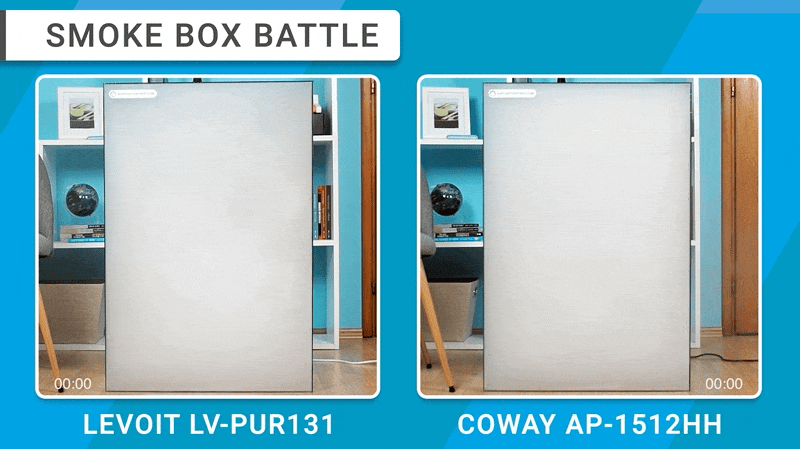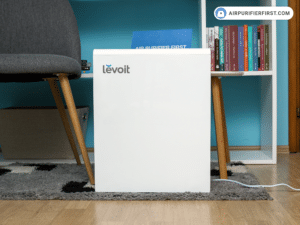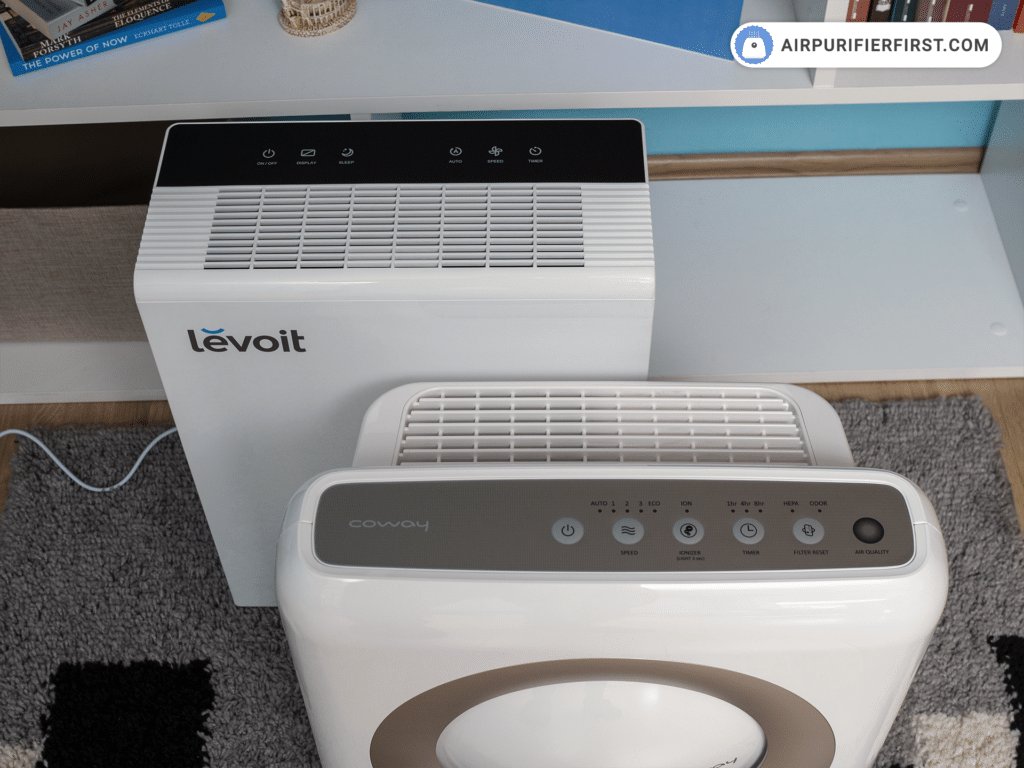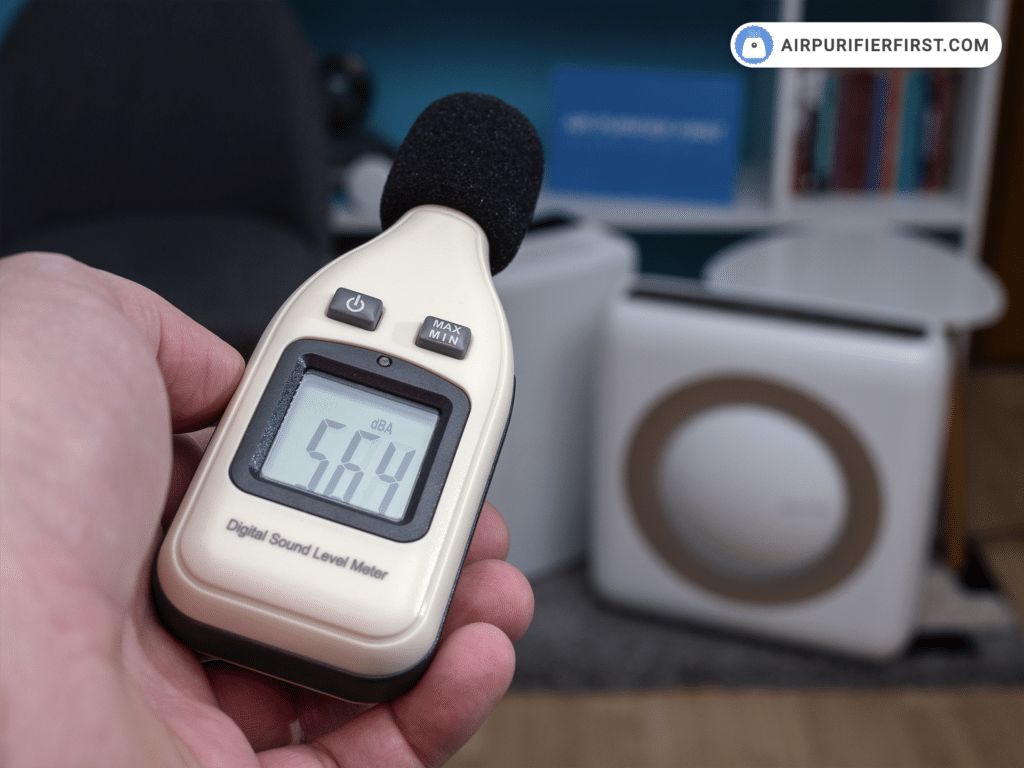Coway AP-1512HH and Levoit LV-PUR131 are air purifiers made by very popular manufacturers. Both companies have been operating in the market for a very long time and have received many positive reviews and satisfied customers.
These devices are somewhat similar in terms of specifications, price, and size. Many users are in a dilemma about which air purifier to choose.

Table of Contents
Levoit LV-PUR131 is designed for rooms up to 322 sq. ft. while Coway AP-1512HH is designed for rooms up to 361 sq. ft. Coway is meant for slightly larger rooms, but that doesn’t have to be crucial in choosing a winner. Yet, there are many more factors that decide which device is better, in my opinion.
Coway has the option in black and white color. Levoit is only available in white color. In the extension of this comparison, I am trying to compare the basic specifications of the Levoit LV-PUR131 and Coway AP-1512HH air purifier, the test results, and on that basis, conclude which of these two products is the better choice to buy.

- Levoit LV-PUR131 – is intended for rooms up to 322 sq. ft., is a very small power consumer, and is very quiet at work. It is equipped with three-stage filtration.
- Coway AP-1512HH – is intended for slightly larger rooms, up to 361 sq. ft. It is equipped with three-stage filtration and an ionizer as an additional stage. Coway has performed exceptionally on all tests and is a very reliable air purifier.
*If you click any of these links and make a purchase, we earn a commission at no additional cost to you.
Levoit LV-PUR131 Vs Coway AP-1512HH Specifications
 |
 |
|
| Manufacturer | Levoit | Coway |
| Model | LV-PUR131 | AP-1512HH |
| Dimensions | 14.6 x 7.2 x 18.5 inches (37 x 18.3 x 47 cm) | 16.81 x 9.65 x 18.30 inches (42.7 x 24.5 x 46.5 cm) |
| Weight | 11.24 lb | 12.76 lb |
| Room Coverage (4.8 ACH) | 322 sq. ft. (30 m²) | 361 sq. ft. (33 m²) |
| Performance Ratings | ||
| Filtration Technology | Pre-filter, Activated Carbon Filter and True HEPA Filter | Pre-filter, Deodorization Filter, True HEPA Filter, and Ionizer |
| Filter Replacement Indicator | Yes | Yes |
| Filter Longevity | 6-8 months | up to 12 months |
| Power | 40W | 77W |
| Operating Costs Ratings | ||
| Fan Speeds | 4 – Sleep Mode, Speed 1, Speed 2, and Speed 3 | 3 – Speed 1, Speed 2, and Speed 3 |
| Air Quality Sensor | Yes | Yes |
| Air Quality Indicator | Yes | Yes |
| Auto Mode | Yes | Yes |
| ECO Mode | No | Yes |
| Display Off | Yes | No |
| Ionizer | No | Yes |
| Noise Levels | 41.6 – 59.3 dBA | 41.4 – 63.5 dBA |
| Noise Ratings | ||
| Warranty | 2-year | 3-year |
| In-Depth Review | Levoit LV-PUR131 | Coway AP-1512HH |
| Price | Check Price on Amazon | Check Price on Amazon |
Features Overview
The Coway AP-1512HH and Levoit LV-PUR131 have many identical features that I won’t individually emphasize. Suppose you are looking for a more detailed explanation of the specifications of these two products. In that case, my recommendation is to look at the individual reviews.

Standard options that characterize these two products are the filter reset indicator, timer, smart sensor, and air quality indicator. The filter reset indicator notifies you when it is time to replace the filter. The Levoit LV-PUR131 has a sleep mode, which switches the fan speed to the lowest and turns off all symbols on display.
Smart Sensor
Both devices use a smart sensor, which measures the current air quality in the room. In both devices, the smart sensor detects only dust particles and determines the air quality based on that. Both devices display the air quality in such a way that the Air Quality Indicator lights up in a different color depending on the air quality in the room.

The big difference is that the Coway AP-1512HH smart sensor is much more advanced than the smart sensor in the Levoit LV-PUR131. The reason is that the sensor’s sensitivity in the Coway model can be adjusted, and based on that, you can determine how much precision and how thoroughly you want the device to purify the air in your room.
Auto Mode
Auto mode is an option that works in combination with the smart sensor.
If auto mode is on, the device automatically changes the fan speed based on the current room air quality.
When auto mode is turned on the LV-PUR131 air purifier, the air quality indicator appears on display. I don’t like that the air quality indicator is only displayed if the device is turned on in auto mode. With Coway, auto mode works identically. The difference is that the air quality indicator on this device is always on. Still, it can be turned off at the request of the user.
ECO Mode
ECO mode is an advanced mode owned only by the Coway air purifier.
If the air purifier is switched to ECO mode, the device saves additional power.
When in ECO mode, the device turns on when the air in the room is dirty and automatically turns off when the air is at a satisfactory level.
Vital Ion System
The Coway AP-1512HH uses an ionizer as an additional filtration stage.

The ionizer is turned off by default and can be turned on by pressing the “Ionizer” button. I will not elaborate on this option in detail because I have already done so on the individual review that you can find on the website.
Timer
Both devices use a timer, which is a handy option if you want to set the air purifier to turn off for a certain amount of time. The difference in timers between these two devices is that Levoit allows you to set the timer in the range of 1h to 12h, while you can set Coway to 1h, 4h, or 8h.
Airflow
Airflow is slightly different with these two devices. The Levoit LV-PUR131 draws in air from the device’s back through openings on the sides and bottom. The air is then filtered and exits through the grilles on the upper side of the device.

The Coway AP-1512HH draws in air from the front through openings at the sides and bottom, as well as through the center of the front cover. The air is then purified and exits at the top of the device.
Levoit LV-PUR131 Vs Coway AP-1512HH Video Comparison
Filtration Technology
Filtration also differs between the two devices. Levoit uses a 3-in-1 filter that is connected from one part, while Coway uses 3 separate filters. The pre-filter is the first stage of filtration in both devices. It is important to note that both devices use a True HEPA filter, which is anticipated from these two brands.

In my opinion, the most significant difference is in the carbon filter. Coway uses a fibrous filter coated with carbon, while Levoit uses activated carbon pellets. Therefore, the activated carbon filter in Levoit is a bit more efficient and showed better results in tests.
Besides, as an arbitrary, 4th stage filtration, Coway uses an Ionizer.
The filters are not washable. However, I recommend cleaning the pre-filter periodically to remove the parts of large dust particles.
How to replace filters?
In the case of the Levoit LV-PUR131, you should change the filter on average between 6 and 8 months.
Coway AP-1512HH True HEPA filter is changed every 12 months, while the Carbon filter is changed on average every 6 months.
Both devices use a filter reset indicator, so you won’t have to worry about when it’s time to replace the filter. The device will let you know when it is time to replace the filter.
Noise Test
Generally speaking, these two devices are loud at the highest speed, while the loudness at other speeds is bearable. The quality of both motors is at an excellent level, so the sound produced by the devices will be pleasant and will not bother you, even if the devices are running the whole day.

The Coway AP-1512HH uses 3 fan speeds, while the Levoit LV-PUR131 uses 3 fan speeds and sleep mode. At first speed, Coway produces a sound of 41.4 dBA, while Levoit, at first speed, produces a sound of 46.1 dBA.
| Product | Noise Range (dBA) |
|---|---|
| Levoit LV-PUR131 | 41.6 – 59.3 dBA |
| Coway AP-1512HH | 41.4 – 63.5 dBA |
Levoit produces 41.6 dBA of sound in sleep mode. Interestingly, Coway is much quieter at first speed than Levoit in sleep mode. Honestly, I like the Coway sound; it is somehow more muffled and more pleasant than the sound in Levoit.
Performance Tests
Because the devices are intended for rooms of almost identical dimensions, I tested them in identical conditions. I did the test in a room of identical dimensions; the difference is that on one test, the devices worked on max fan speed , and on the other test on auto mode.

Detailed tests of these two air purifiers are shown below.
320 sq. ft. Room Test
I tested both products in a 320 sq. ft. room. The tests were separated and lasted 60 minutes, during which both devices worked at their maximum speeds.
The Levoit LV-PUR131 improved air quality by about 92% in 60 minutes. This is an excellent result, and I must say that I am satisfied. At the same time, the Coway AP-1512HH improved air quality by about 96% in the same room. This is a great result, completely expected from a device of this quality.
320 sq. ft. Room
* Data measuring time is 60 minutes.
I can say that the result that Coway made is one of the best results when I compare all the devices I have had the opportunity to test so far.
320 sq. ft. Room Test – Auto Mode
After the first test, I tested the devices in the same room, but they worked in auto mode this time. I have already mentioned that Coway has a drastically better smart sensor, so I expect better results in this test.
Levoit LV-PUR131 improved air quality by about 86% in a room of 320 sq. ft. in 60 minutes of work on auto mode, which is a decent result. The Coway AP-1512HH performed better in this test as well, so it improved air quality by about 90% in 60 minutes. In doing so, AQI dropped from 134 to 12.
320 sq. ft. Room
* Data measuring time is 60 minutes.
Overall, both devices did very well, although Coway did slightly better.
Operating Costs
Levoit LV-PUR131 is a 40W device, while Coway AP-1512HH is a 77W air purifier. As you can see, the Coway is almost twice as powerful as the Levoit. As a result, the motor and airflow at Coway are higher than at Levoit.

Besides, electricity consumption is slightly higher at Coway. However, combined with ECO Mode, which drastically saves both electricity and filters, I can say that consumption does not differ much.
| Product | Wattage Range (W) |
|---|---|
| Levoit LV-PUR131 | 0.7 – 34.5W |
| Coway AP-1512HH | 0.2 – 69.1W |
Let’s compare the electricity consumption and the price of replacement filters on an annual basis. We can conclude that the cost of maintaining these two devices yearly is almost identical.
Which One Does It Better?
This, however, was not an uncertain struggle as I had expected.
Although in some fields Levoit LV-PUR131 and Coway AP-1512HH made identical results, still Coway stood out a lot and showed that it is a better choice than Levoit.
Coway, in addition to it, has made better performance and is a bit quieter at lower speeds, offers a host of advanced options, such as ECO Mode and Smart Sensor Sensitivity adjustment. Because of all this, my absolute recommendation and the winner in this comparison is the Coway AP-1512HH.
Leave a Reply